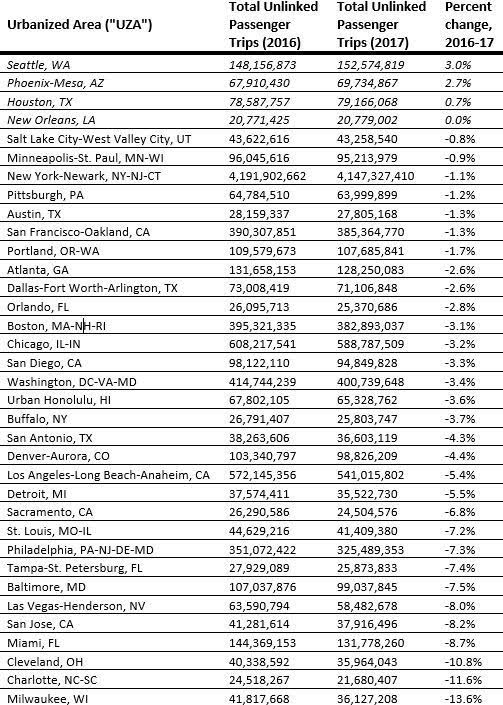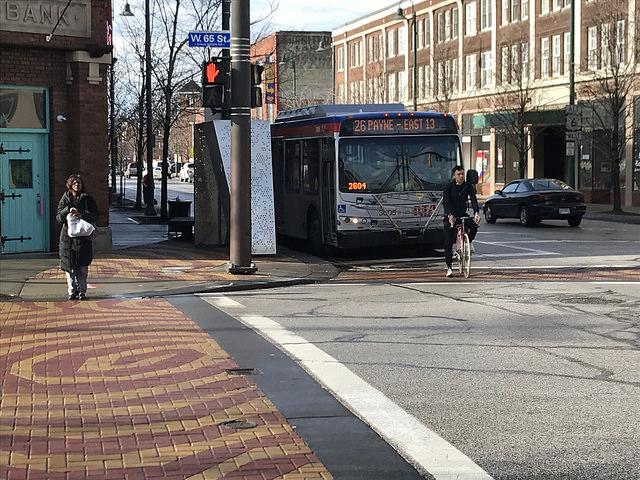American cities should start thinking a lot harder about how they're going to get people back on the bus.
Transit ridership is falling in 31 out of 35 major U.S. transit markets. There's no shortage of challenges for transit right now: cheap gas, cheap car loans, and cheap ride-hailing apps all exert a pull, tugging at people to choose a car instead of a bus or a train.
But that's no excuse for failing to make transit an effective travel option that gains more riders. Despite all the factors working against transit, a few cities have managed to buck the trend and grow ridership, and other cities should learn from their example, according to the experts at TransitCenter.
The big standout is Seattle, where transit ridership increased 3 percent in 2017 compared to the previous year. A few other cities have managed to avoid losing riders:

The cities toward the top of this list are doing a few big things right, says TransitCenter's Zak Accuardi. Here's how he describes the recipe for growing ridership, even in a challenging environment.
You can do more with more resources
This is not exactly surprising, but the places where more people are choosing to ride transit have made significant investments in transit.
Seattle and King County operate 13 percent more transit service today than in 2014, after bringing light rail expansions online while adding bus service. Those improvements were funded by ballot measures to raise revenue for transit. The effects of a huge 2016 transit ballot initiative have yet to even register.
In Phoenix, the other high performer, voters approved a sales tax hike in 2015 to fund $31 billion in transit upgrades. More than half the revenue is dedicated to bus improvements, and increased service is already paying off with higher ridership.
Improve the whole system, not just one route at a time
Of course, simply spending resources on transit doesn't mean you're spending them well. What distinguishes cities that are bucking the trend, says Accuardi, is their emphasis on the whole system, not just improving or adding one route at a time.
Seattle and Phoenix, for instance, both implemented substantial increases in bus service as they planned long-term investments in light rail lines.
Houston, one of the better performers, has not only added light rail routes in recent years, it's also completely redesigned its bus network, emphasizing the provision of frequent service to more neighborhoods and beefing up weekend service.
Columbus, another city that recently overhauled its bus network, is also outperforming its peer cities in transit ridership, says Accuardi.
Consider transit in Ohio. Columbus overhauled its bus network in mid-2017, with plenty of public conversation & strong framing of transit’s importance by city leaders
— TransitCenter (@TransitCenter) March 21, 2018
COTA, Columbus -0.8% ***
SORTA, Cincinnati -5%
RTA, Cleveland -11.4%
(Bus ridership 2017 v 2016, FTA) https://t.co/595xnxxB0U
While Columbus and Houston are doing relatively well, the ridership changes in 2017 weren't exactly impressive either. Neither city increased its bus service budget as part of its network redesign. Without devoting resources to increased service, there's only so much that adjustments to the network can do, said Accuardi.
Although the regional 2017 numbers in the table above don't make it very clear, another city that's gaining riders thanks to systemwide improvements is San Francisco -- specifically Muni, the agency run by the city.
Muni ridership has increased 3.6 percent since 2012, and Accuardi credits the Muni Forward initiative, "a comprehensive, citywide plan that is driven by the municipality."
Muni Forward aims to improve bus speed and reliability throughout the system. San Francisco was the first major American city to implement citywide all-door boarding, and the Muni Forward program continues add features like bus lanes and walkability improvements near transit stops.
That kind of approach is "the only thing we can point to really clearly to say, 'This is how you grow transit ridership,'" said Accuardi.






